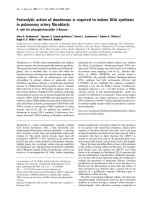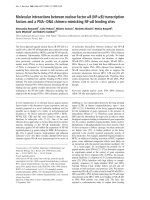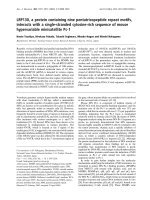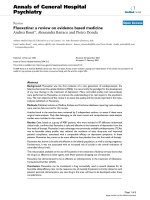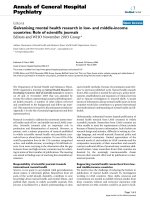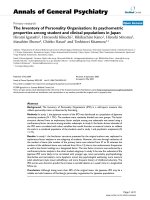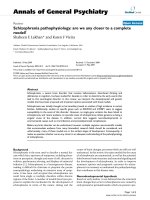Báo cáo y học: "Leveraging a clinical research information system to assist biospecimen data and workflow management: a hybrid approach" pptx
Bạn đang xem bản rút gọn của tài liệu. Xem và tải ngay bản đầy đủ của tài liệu tại đây (477.87 KB, 8 trang )
DATABASE Open Access
Leveraging a clinical research information system
to assist biospecimen data and workflow
management: a hybrid approach
Prakash M Nadkarni
1*
, Rowena Kemp
1
and Chirag R Parikh
1,2
Abstract
Background: Large multi-center clinical studies often involve the collection and analysis of biological samples. It is
necessary to ensure timely, complete and accurate recording of analytical results and associated phenotypic and
clinical information. The TRIBE-AKI Consortium supports a network of multiple related
studies and sample biorepository, thus allowing researchers to take advantage of a larger specimen collection than
they might have at an individual institution.
Description: We describe a biospecimen data management system (BDMS) that supports TRIBE-AKI and is
intended for multi-center collaborative clinical studies that involve shipment of biospecimens between sites. This
system works in conjunction with a clinical research information system (CRIS) that stores the clinical data
associated with the biospecimens, along with other patient-related parameters. Inter-operation between the two
systems is mediated by an interactively invoked suite of Web Services, as well as by batch code. We discuss various
challenges involved in integration.
Conclusions: Our experience indicates that an approach that emphasizes inter-operability is reasonably optimal in
allowing each system to be utilized for the tasks for which it is best suited.
Keywords: Biospecimen data management, clinical research information systems, multi-center clinical studies,
biorepositories
1 Background
Research to improve health care is increasingly supported
by advances in genomics, proteomics and metabolomics.
To allow statistically meaningful analyses, all of these
methodologies demand large numbers of adequately col-
lected and annotated biospecimens from both diseased
and non-diseased individuals [1], which can often be
obtained only through multi-center studies. It is es sential
to ensure timely, complete and accurate recording of
analytical results and associated phenotypic and clinical
information. Well-managed Biorepositories - entities that
support receipt, storage, processing and/or distribution
of biospe cimens [2] through standardized operating pro-
cedures, along with management of their associated data-
have consequently become essential aids in inve stig ating
the causes and prognosis of human diseases.
Development of biomarkers f or acute kidney injury
(AKI) is a top research priority: the US National Institute
of Diabetes, Digestive and Kidney Diseases, part of the
NIH, supports the TRIBE-AKI consortium (Translational
Research Investigating Biomarker Endpoints in Acute Kid-
ney Injury) for this purpose />AKI occurs in 2-5% of hospitalized patients - it compli-
cates shock due to any cause, trauma with muscle injury,
hemolytic condit ions and cardiac surgery, among other
conditions [3]. Outcomes associated with AKI have
remained unchanged over several decades, and large
multi-center studies may be necessary to ensure adequate
cohort/sample size for various purposes, e.g., biomarker
development and validation.
Multi-center studies often involve biospecimen collec-
tion at various sites and shipping of biospecimens
* Correspondence: Prakash.Nadkarni@yal e.edu
1
Yale University School of Medicine, New Haven, CT, USA
Full list of author information is available at the end of the article
Nadkarni et al . Journal of Clinical Bioinformatics 2011, 1:22
/>JOURNAL OF
CLINICAL BIOINFORMATICS
© 2011 Nadkarni et al; licensee BioMed Central Ltd. This is an Open Access article distributed under the terms of the Creative
Commons Attribution License ( which permits unrestricted use, distribution, and
reproduction in any medium, provided the original work is properly cited.
between sites and a sample coordinating center for
purposes of storage and analysis. Related informatics
support involves tasks such as barcode generation, bios-
pecimen storage/inventory management, tracking of
biospecimen requests and aliquot consumption, and
management of the analytic data generated from the
specimens. Organizations such as the International
Society for Biological and Environmental Repositories
(ISBER) provide guidelines and best practice suggestions
for standard operating procedures to create and operate
a Biorepository, e.g., [2, 4]. Most of the guidelines, how-
ever, focus on biospecimen banking and distrib ution,
and not on data management [5].
This paper describes the design and implementation of a
biospecimen data management system (BDMS), originally
developed for the TRIBE-AKI consortium, that facilitates
the workflow involved in multi-centric scenarios that
involve longitudinal cohort follow-up with biospecimen
collection and analysis. The system also communicates bi-
directionally with a clinical research information system
(CRIS) that manages the analytic data.
2 Construction and Content
To provide a rationale for our architectural decision, we
first describe multi-centric study workflow, which dictates
software requirements and design. We then summarize
the issues of overlapping functionality between BDMS and
CRIS software, and user interfaces to clinical/biospecimen
data.
2.1 Workflow of Biospecimen Collection and Processing in
Multi-centric studies
Enrollment of patients based on the p rotocol’sinclusion
and exclusion criteria is a complex process as such indivi-
duals are rarely available immediately. The study proto-
col’s “ event calendar“, a predetermined sequence of time
points ("events”) relative t o a subject’s enrollment date,
determines the biospecimen-collection schedule. Note that
many or even most time-points are not associated with
biospecimen collection, but may involve subject inter-
views, clinical examination, special investigations (e.g.,
radiology) or outreach (e.g., reminders through phone, let-
ters or E-mail). The numerous study parameters recorded
across all events, such as measures of disease progression
or clini cal improv ement specific to the disease condition
being followed, are segregated into logical ly-related units
called case report forms (CRFs).
In order to reduce shipping costs, centers perform local
biospecimen processing, aliquot creation and temporary
storage p rior to batch shipments. The actual number of
aliquots may vary for individual subjects because of mate-
rial-collection constraints (especially in pediatric
patients): in intensive-care/emergency situations, sche d-
uled collections may b e missed. Actual biospecimen
collection and quantity must be closely tracked to inform
the study progress. To streamline collection and proces-
sing, an analytic center typically provides collection cen-
ters in advance with a batch of aliquot containers (vials)
and the barcode labels record standard information such
as patient ID, event, sample type and aliquot number.
The samples a re batch ship ped and aliquots that are
received are scanned at the data and sample coord inating
center for verification against the previously entered col-
lection data. Discrepancy-resolution generally involves
humanintervention(e.g.,phone calls to collection cen-
ters). After any additional local processing if necessary,
aliquots are stored in freezers, with locations recorded
using a coordinate system (e.g., site-freezer-rack-slot).
Biospecimens are consumed following local analysis or
shipping to external biomarker laboratories, either in
bulk for specialized analyses, or when individually
requested by collaborators . For the former, t he external
lab may sen d analytical results back in a varie ty of for-
mats (typically in spreadsheets), and these must also be
bulk-imported. Specimen consumption must be tracked
accurately to guide future ancillary studies and sample
requests.
2.2 Existing Software for Biospecimen Management
Because individual research groups’ needs vary greatly,
existing BDMS fu nctionality is very diverse: however, all
BDMSs shoul d be able to manage an unlimited number
of study protocols: every data element must be asso-
ciated, directly or indirectly, with the study where it
originated.
Angelow et al [6] describe a “virtual repository” BDMS:
biospecimens are not shipped, but stored (and analyzed) at
individual collection centers, but managed by a central
web-based BDMS. Pulley et al [7] describe a DNA bio-
banking system for anonymous subjects: each biospecimen
is associated with structured and textual electronic-medi-
cal-record (EMR) data that is anonymized using electronic
and manual processes. This data characterizes individual
phenotypes: genotype-phenotype correlations form a focus
of the eMERGE network [8].
CaTissue [9], supported by the Cancer BioInformatics
Grid (CaBiG) [10], focuses on tissue banking, providing
functionality such as clinical annot ations (e.g., pathology
reports), but also has general-purpose features. The anno-
tation module has been utilized by other groups [11,12].
2.3 CRISs and BDMSs: Overlapping Functionality
Clinical Research Information Systems (CRISs) [13-15],
with prices ranging from free to several million dollars,
are designed to manage workflow and data for an arbi-
trary number of studies. Both CRISs and BDMSs typically
utilize h igh-end relational database management systems
(RDBMSs). When BDMSs are used for clinical studies,
Nadkarni et al . Journal of Clinical Bioinformatics 2011, 1:22
/>Page 2 of 8
they address many areas covered by CRISs (though often
in greater depth) as discussed shortly. Despite this over-
lap, even high-end CRISs do not currently provide com-
prehensive BDMS capability: biospecimen-inventory
management, in particular, falls significantly short.
Large research groups therefore employ both types o f
systems. In such scenarios, one must determine whether
one system shall be used primarily for a particular fu nc-
tion (or whether both sho uldbeusedforcomplemen-
tary functionality), and how to coordinate both systems’
contents. Consider the following synchronization
challenges:
1.
Users: A large multi-center study may involve hun-
dreds of research staff across sites, with a variety of access
privileges to either system: staff turnover may be signifi-
cant. We consider this issue later in the Discussion.
2.
Informed Consent: Consent often has finer details
related to the degree of participation allowed by the sub-
ject. Based on research goals, subjects may consent to
provide some tissues but not others, or to have only cer-
tain tests performed: e.g., they may decline genotyping
because of concerns (in the USA) that accidental result
disclosure may impact their families’ health-insurability.
Biospecimens may inherit their consent values from the
subject (e.g., if the subject drops out and w ithdraws con-
sent, the consent status of all specimens must automati-
cally change).
3.
Collection Schedules: As stated earlier, the study
calendar is a su perset of the biospecimen-collection
calendar. For subjects’ convenience, individual collection
visits also serve other purposes (e.g., physical examina-
tion, interviews), and visits are frequently rescheduled.
4.
Analytical Data: The subject’s total clinical data
constitute a superset of biospecimen-associated analytic
data, which are rarely inspected in isolation. Research
staffs typically enter/edit non-analytical data, either
through real-time electronic data capture, or on paper
that is later transcribed electronically by data-entry staff.
While analytical data can also be entered manually,
many parameters may be outputted electronically by
labora tory instruments following batch analyses, and are
preferably bulk-imported.
When both systems are in use, issues 3-4 above result in
maximizing CRIS use. However, there is some data ov er-
lap - e.g., patient identifiers, basic study protocol informa-
tion, etc. and consequently, data exchange is unavoidable.
2.4 User Interfaces for Clinical Data
User interfaces for interactive data capture must support
robust validation and ergonomics. Parameter-level valida-
tion includes data type, range and set-membership, and
mandatory (non-empty ) values. Cross-parameter valida-
tion involves testing of rules (e.g., the differential white
blood cell count components must total 100). Ergonomic
aids include automatic computations of parameters based
on formulas, disabling of certain fields based on values of
previously entered fields (so called “skip logic” )andkey-
word-based search of controlled biomedical vocabularies.
Finally, based on the study calendar, individual para-
meters may only be recorded for the CRFs/time-points
where they a pply. The ap proach of programming such
capabilities manually (e.g., Angelow et al). takes signifi-
cant expertise and effort, and does not scale. Alternative
user-interface-management approaches include:
1.
Managing collection schedules and analytical data
through the BDMS. CaTissue lets developers specify a
Unified Modeling Language (UML) data model, generat-
ing relational tables and a basic form interface that sup-
ports only data-type and set-membership checks.
Calendar functionality (e.g., reminders, reports) lags
considerably behind that of CRISs,.
Several commercial BDMSs (e.g., FreezerPro [16] and
FreezerWorks [17]) provide more end-user-friendly and
more full featured alternatives: some of these are Web-
based, while others use two-tier technology (i.e., custom
client software installed on multiple desktops communi-
cating directly with a database). In any case, such systems
address longitudinal-clinical-study needs only partially.
2.
Delegating cale ndar and analytical-data ma nagement
to a CRIS. CR ISs typically provide extensive interface-
generation as well as calendar-driven capabilities: they
allow designer-level users to sp ecify the interface declara-
tively through a data library, and then generate CRFs. We
employ this design approach.
3. System Architecture
The BDMS communicates bi-directionally with a full-
function Web-based ope n-source CRIS, TrialDB [18,19],
which has the ability to generate full-featured CRFs.
TrialDB is a general-purpose CRIS that has been used
for studies ranging from psychiatry, medical and surgical
oncology to endocrinology. The CRIS is also the
BDMS’s external face. In our current set-up, only a few
individuals, limited to a single laboratory, need edit
access to the BDMS: external users need read-only
access to subsets or aggregates of the BDMS data. The
limited-edit-access constraint allows us to implement
the BDMS using an Intranet-access-only, two-tier design
- a Microsoft Access front-end to a Microsoft SQL Ser-
ver RDBMS.
Two-tier solutions are inherently less scalable than
Web-based ones, which are “three-tier” -aWeb-server
application intervenes between the client (browser) and
the database. However, greater toolset maturity allows sig-
nificantly easier software development and modification,
which is important when the system’s functionality is
Nadkarni et al . Journal of Clinical Bioinformatics 2011, 1:22
/>Page 3 of 8
evolving rapidly. Also, we use code libraries to facilitate
eventual porting to a Web-based architecture (as discussed
later): TrialDB itself was developed this way.
3.1 Database Schema
Figure 1 illustrates the database schema. Additional File
1 contains an annotated description o f individual tables
and columns.
The tables can be grouped into the following categories:
1. Metadata ( definition) tables imp orted from the
CRIS: these contain a subset of the corresponding
CRIS information - the b are minimum n ecessary for
the BDMS to function. Thus we have basic informa-
tion on study protocols, research sites, types of speci-
mens, calendar information, and the planned
collection schedule (including the number of speci-
mens/aliquots of each type scheduled for collection at
each time-point).
Metadata is imported after study-protocol definition.
It changes very infrequently during the study
(significant changes to the protocol typical ly have to
be IRB-approved): BDMS-CRIS synchronization typi-
cally happens just once.
2. Subject/patient-related data imported from the
CRIS. This data (also a CRIS subset) includes basic
patient-identifying information and enrollment sta-
tus, plus information on the specimens/aliquots
actually collected. Synchronization is periodic - just
before anticipated arrival of a sample batch, or when
certain changes occur in the CRIS.
3. Biospecimen/Inventory data managed primarily by
the BDMS: available storage locations, actual storage
locations for specimens, details of individual biospe-
cimens, shipping requests and shipments, and a his-
tory of operations performed on a biospec imen (e.g.,
shipping, processing, consumption).
4. Mapping Tables: (not shown in figure). These tables,
which record the correspondence between BDMS and
CRIS data elements, facilitate export of BDMS data to
the CRIS. These tables have a structure highly specific
to the CRIS, and are not discussed further.
Figure 1 Database schema.
Nadkarni et al . Journal of Clinical Bioinformatics 2011, 1:22
/>Page 4 of 8
3.2 System Functionality
We summarize BDMS functionality under the following
categories:
•
Barcode generation: Barcode labels for each aliquot
container are generated (using the Abarcode Inc.
toolset, ) according to
designer-specified templates: e.g., in addition to a
machine generated barcode with a check-digit, we
also include identifying information such as surrogate
Patient ID, collection date, protocol ID and specimen
type. Based on collection circumstances, all aliquot
containers may not be utilized.
Barcodes are stored as strings rather than numbers:
this allows database pattern-match search in the
uncommon (but not negligible) event of partial scan.
•
Inventory/storage: The capability includes: assign
storage location for specimens, locate a given speci-
men, all specimens for a given patient or set of
patients, summarize contents of a given location/
sub-location, list unused locations, track sample con-
sumption, report available aliquots for a given sub-
ject/time-point, etc.
•
Shipping Management: Functions include: accept
new s pecimen s, select multiple samples for external
shipping/analysis, list s pecimens associated with a
given shipping container, etc.
•
Bulk Import of analytical results into CRI S: Results
arrive in a variety of data formats, e.g., Excel spread-
sheets. Rather than force external labs t o return data in
a specific format, we accept their format a nd bulk-
import data using a set of mapping tables that map col-
umns in their data (patient ID, time-point, analytical
result) to CRIS data elements. Mapping is performe d
through a point-and-click interface. Utilization of speci-
men aliquots by analytical processes is also used to
track consumption and update inventory. Similarly, we
can track requests associated with individual patients
(typically made by research collaborators).
•
Consent Management: We do not try to manage spe-
cimen-consents within the BDMS: these are simulated
in the CRIS by treating different types of consent as
though they were clinical parameters. We have found
this approach workable.
3.3 Integration between CRIS and BDMS
There are two types of situations where sy nchronization
of CRIS and BDMS are needed.
3.3.1 Interactive Updates
These typically involve a single subjec t, and mostly
occur when an end-user is interacting with the CRIS
using a CRF; a real-time push of data related to that
subject from the CRIS, or a pull from the BDMS, is
needed. Inter-system communication occurs t hrough a
Web service implemented using the lightweight REST
(Representational State Transfer) approach [20]. Here,
the client (i.e., the Web page) communicates with a ser-
ver through a uniform interface consisti ng of a series of
self-descriptive messages. No client context is stor ed on
the server between requests: i.e., the invocation is
stateless.
An extension mechanism built into TrialDB allows a
service specification to be part of th e CRF definition:
the specification consists of the service URL (which is
https-based), a caption and description. When the CRF
is g enera ted, a butt on with the caption (and an ac com-
panying description/explanation) is created at the foot
of the page. Clicking the button executes the URL,
which takes a single parameter, the symmetrically
encrypted primary-key value of the CRF instance in the
CRIS. This value allows the service to determine the
current Subject, Study/Protocol, TimePoint, and the
values of individual clinical parameters embedded within
the current CRF.
InthecaseoftheCRIS,theserviceisimplemented
part of the CRIS application, so that it is able to utilize
the current session information (which records informa-
tion such as the current user, current study that the
user is working with, etc.) for authentication. Effectively,
an additional parameter, a uniquely identifiable session
ID, is passed in the URL by the Microsoft ASP.NET fra-
mework (which is used to create the Web applicatio n).
The service accesses both the BDMS and CRIS database
schemas directly using the well-known Open Database
Connectivity (ODBC) protocol [21], which allows pro-
grammatic access to diverse RDBMSs using a vendor-
independent SQL syntax.
3.3.2 Batch Updates
Batch operations typically push summarized BDMS data
of multiple patients- e.g., number of currently available
biospecimens/aliquots for all subject s (by time-point and
specimen type) - into the CRIS. Here, the BDMS front-
end code accesses bot h schemas using ODBC directly.
Here, a REST approach is possible (Microsoft Access sup-
ports Web service invocation), but it is probably overkill
currently. However, we do not rule it out if the BDMS
concurrency load increases in the future.
4. Utility and Discussion
4.1 The Challenges of Creating “Universal” BDMSs
It is challenging to create BDMSs to meet all possible pur-
poses equally well. While CaTissue aims to be general-
purpose, it has the following limitations.
• As previously stated, analytical-data-interface-
design and calendar capabilities fall well short of
standard CRIS functionality.
Nadkarni et al . Journal of Clinical Bioinformatics 2011, 1:22
/>Page 5 of 8
• Biospecimen-related workflow is excessively elabo-
rate for most clinical studies, which limit biospeci-
mens to simpler tissue sources (e.g., blood, urine,
DNA).
• Barcode-generation functionality that is built into
most BDMSs must be programmed by creating a
Java-based Web service.
• It lacks biospecimen-lineage-tracing functionality:
in combination with storage-location information,
this helps identify possible contamination, which
occurred with HeLa cells [22,23].
• The CaTissue data-security model does not address
subjects’ Personal Health Information (PHI). PHI
must typically be stored encrypted in multi-centric
studies where subjects have not consented to have
their PHI accessible outside their own site. (Angelow
et al implement site-specific PHI encryption, with
dynamic decryption within https for web-based view-
ing.) Plaintext-PHI-storage increases the risks of acci-
dental/malicious disclosure, as happened with the
Epsilon break-in [24].
CaTissue attempts to handle privacy by making PHI
columns optional. This strategy, unfortunately, makes
the software unusable for operations involving interac-
tion with subjects (for scheduling, or personal follow-
up). To prevent patient- m isidentification errors in
clinical care, WHO guidelines [25] require patient-
identity confirmation using least 2 PHI identifiers,
such as name and date of birth - which must also be
stored securely. Patients identified within a system
onlybyanonymousalphanumericIDshaveasignifi-
cant likelihood of misidentification, and are put at risk
if analytical results determine clinical interventions or
workflow decisions. Therefore it is desirable to estab-
lish the right balance between patient privacy and
patient safety.
TrialDB uses fairly well-known strategies based on
disk-based encryption, combined with role-based
access, so that only those i ndividuals who ne ed to se e
PHI are given access to it. The implementation uti-
lizes dynamic interface generation with suppression
of PHI fields as needed. PHI-privileged individuals
are typically restricted to data (not just PHI) for sub-
jects from their own site.
A relatively minimalist solution where a CRIS intero-
perateswithaBDMScanbeworkablebecauseitlets
each system focus on what it does best.
4.2 Current Status and Future Directions
While TrialDB has been in production use at Yale and
elsewhere for at least a decade, the integrated BDMS
functionality has been implemented relatively recently,
and is i n use for four multi-center studies. Our choice of
TrialDB was dictated, of course, by our intimate familiar-
ity with it. In theory, we could have extended TrialDB to
incorporate BDMS functionality. However, the first ver-
sion of the BDMS had to be created under somewhat
stringent time constraints that, combined with the fo rtu-
nate requirem ent of limited edit access, more or less dic-
tated the two-tier development route.
Such a situation is not likely to hold forever, and at
some future point, the number of concurrent BDMS users
will increase, requiring migration to a Web-based architec-
ture. However, the creation of a separate BDMS has
allowed us to it eratively refine it without impacting the
stability of t he TrialDB code. It also occurred to us that
such an approach could serve as a demonstration of inter-
operation between systems that are likely to evolve inde-
pendently, so that our architecture could be employed in
other institutions that do not have the luxury of being able
to modify their CRIS’ssourcecode.
4.3 Integration Challenges
Consortiums such as CDISC (Clinica l Data Interchange
Standards Consortium) are working
to facilitate the interchange of data and metadata between
CRISs through interchange models such as CDISC-ODM
(Operational Data Model) [26]. However, the area of bios-
pecimen collection a dds an extra dimension to the pro-
blem, which CDISC is not currently addressing. Data
interchange between BDMSs, or between CRISs and
BDMSs, is therefore likely to require ad hoc approaches
for a while.
The difficulty of implementing interoperability between
systems is greatly magnified by proprietary software with
closed architecture or poorly documented internals. Even
with open-source, well-documented systems, however, the
issue of synchronizing the contents of the systems for
overlapping functionality remains. Further, CRISs and
BDMSs are not the only two systems involved in clinical
study workflow: financial/accounting systems must track
the services recorded as performed in the CRIS/BDMS,
grants-management software and possibly special-purpose
patient-scheduling software must similarly integrate.
We now consider in depth synchronization challenges
related to users. Currently, because of the restricted access
to the BDMS in our setup, we have not had to deal with
this issue, but we expect to be forced to in future.
4.3.1 Managing and Coordinating User Roles across
Systems
High-end database applications prohibit database-login
access by end-users. Instead, users can only login to the
application, which then connects to the RDBMS using a
service account. This approach is highly scalable. Most
users’ inter actions with the application consist of brows-
ing and editing operations: modern CPUs, which perform
many operations in under a nanosecond, would spend a
Nadkarni et al . Journal of Clinical Bioinformatics 2011, 1:22
/>Page 6 of 8
relative eternity waiting for user actions. A single service
account can multiplex to serve numerous users, connect-
ing to the database only for the few milliseconds needed
to fulfill an individual user’s data request, becoming avail-
able for another user immediately after execution.
Such applications must manage user-access permissions
(privileges). Permissions are typically not assigned to users
directly. Instead, one defines “Roles” (e.g., primary d ata
entry, protocol designer, stud y administrator) that define
permissions (e.g., no access, read-only, read-write) with
respect to various data components. Individual users are
then assigned (or de-assigned) one or more roles. This
indirect approach is more efficient: roles act as permis-
sion-setting shortcuts, andtheyaremuchfewerthan
users.
RDBMSs can be used to define roles: service account
privileges are defined mostly at the RDBMS level. How-
ever, it makes sense to additionally define them at the
application level - e.g., for study-level access, where a user
is limited to accessing only one or two studies in a system.
Application-level roles can be used to customize the user
interface dynamically- e.g., by disabling menus or other
user-interf ace objects tha tdonotapplytothecurrent
user.
Many users tend to have similar roles across systems:
permissions across systems must therefore be coordinated.
Study-level access, for example, must always propagate
across all systems used to manage study workflow.
4.3.2 Maintaining Audit Trails: Restricting User Actions
High-end systems involving human subjects must main-
tain audit trails: audit-trail records are stamped w ith the
ID of the user who made a change, and a date-time of
change. When two systems interoperat e, individual users’
actions may often change data on both systems. Here, the
originating system typically maintains the trail. If, however,
the destination system is also required to log changes, then
user identification and credentials (role information) must
be transmitted - without requiring them to log on to the
other system.
Transmitting user credentials also serves another pur-
pose. It acts as insurance against buggy or malicious appli-
cation code that attempts to execute operations on the
second system that might exceed a particular user’s
authority, thus forestalling “privilege-escalation” attacks
[27].
4.3.3 The Need for Integrated Role Management: Single
Sign-On
As the number of inter-operating systems grows, a uni-
fied approach to user/role management becomes essen-
tial. One widely-used approach is “single sign-on": rather
than logging on to multiple applications individually, the
user logs on to a single “authentication server” system
which accesses a database of user-role information across
applications, and transmits an e ncrypted token (“ticket”)
to an invoked application, which then authenticates the
user and ascertains the user’s privileges for that applica-
tion. The framework we have devised is based on the
Amazon Web Services algorithm description [28] and a
schema published by Sheriff [29]. The schema and algo-
rithm are described in detail in Additional file 2.
5 Conclusions
For management of longitudinal clinical studies invol-
ving biospe cimen collection and analysis, integration of
the capabilities of a CRIS and BDMS can offer signifi-
cant benefits in terms of spectrum of functionality. Such
integration is easier with open architectures and open-
source designs or components, and we hope t hat our
description of our own work will guide others in their
efforts.
6 Availability and Requirements
We provide a design that can be used by investigators
for their own purposes through a detailed technical
description in the additional files associated with this
paper.
Additional material
Additional file 1: Schema documentation. Annotated description of
the BDMS schema, and schema for role management and user
authentication.
Additional file 2: Microsoft Access Schema. Microsoft Access database
containing the above schemas. TrialDB, the CRIS whose use is
summarized in the paper, is freely available for downloading via http://
ycmi.med.yale.edu/trialDB/open_source.shtm. Requirements: It requires an
Oracle back-end schema (a SQL Server version is also available), the use
of Windows 7 servers and Windows XP or Win 7 clients (for study
design) and Internet Explorer v7 or later for the web browser. Detailed
installation instructions are available at />trialdbdownloads/Installation%20Instructions.htm.
Acknowledgments
This work was funded by NIH grant UO1-DK082185 to Dr. Parikh.
Author deta ils
1
Yale University School of Medicine, New Haven, CT, USA.
2
Clinical
Epidemiology Research Center, VAMC, West Haven, CT, USA.
Authors’ contributions
PMN implemented the software; RK and CRP determined the system’s
requirements. All three authors contributed to the writing of the paper. All
authors read and approved the final manuscript
Competing interests
The authors declare that they have no competing interests.
Received: 27 May 2011 Accepted: 25 August 2011
Published: 25 August 2011
References
1. Watson P, Wilson-McManus J, Barnes R, Giesz S, Png A, Hegele R:
Evolutionary concepts in biobanking: The BC BioLibrary. Journal of
Translational Medicine 2009, 7:95.
Nadkarni et al . Journal of Clinical Bioinformatics 2011, 1:22
/>Page 7 of 8
2. International Society for Biological and Environmental Repositories: Best
Practices for Repositories Collection, Storage, Retrieval and Distribution
of Biological Materials for Research. Cell Preservation Technology 2008,
6:3-58.
3. Coca SG, Yalavarthy R, Concato J, Parikh CR: Biomarkers for the diagnosis
and risk stratification of acute kidney injury: a systematic review. Kidney
Int 2008, 73:1008-1016.
4. Troyer D: Biorepository standards and protocols for collecting,
processing, and storing human tissues. Methods Mol Biol 2008,
441:193-220.
5. Ginsburg G, Burke T, Febbo P: Centralized Biorepositories for Genetic and
Genomic Research. JAMA 2008, 299:1359-1361.
6. Angelow A, Schmidt M, Weitmann K, Schwedler S, Vogt H, Havemann C,
Hoffmann W: Methods and implementation of a central biosample and
data management in a three-centre clinical study. Comput Methods
Programs Biomed 2008, 91:82-90.
7. Pulley J, Clayton E, Bernard GR, Roden DM, Masys DR: Principles of human
subjects protections applied in an opt-out, de-identified biobank. Clin
Transl Sci 2010, 3:42-48.
8. McCarty CA, Chisholm RL, Chute CG, Kullo IJ, Jarvik GP, Larson EB, Li R,
Masys DR, Ritchie MD, Roden DM, et al: The eMERGE Network: A
consortium of biorepositories linked to electronic medical records data
for conducting genomic studies. BMC Med Genomics 2010, 4:13.
9. CaTissue Suite. [ />CaTissue_Suite].
10. Cancer Bioinformatics Grid. [].
11. Amin W, Parwani AV, Schmandt L, Mohanty SK, Farhat G, Pople AK,
Winters SB, Whelan NB, Schneider AM, Milnes JT, et al: National
Mesothelioma Virtual Bank: a standard based biospecimen and clinical
data resource to enhance translational research. BMC Cancer 2008, 8:236.
12. Amin W, Singh H, Pople AK, Winters S, Dhir R, Parwani AV, Becich MJ: A
decade of experience in the development and implementation of tissue
banking informatics tools for intra and inter-institutional translational
research. J Pathol Inform 2010, 1.
13. Phase Forward. [].
14. Openclinica. [ />15. REDCap. [].
16. FreezerPro. [ />17. Freezerworks Unlimited. [ />18. TrialDB: a clinical study data management system. [e.
edu].
19. Nadkarni PM, Brandt C, Frawley S, Sayward F, Einbinder R, Zelterman D,
Schacter L, Miller PL: Managing attribute-value clinical trials data using
the ACT/DB client-server database system. Journal of the American
Medical Informatics Association 1998, 5:139-151.
20. QuickStudy: Representational State Transfer (REST). [http://www.
computerworld.com/s/article/297424/
Representational_State_Transfer_REST_].
21. North K: Multidatabase APIs and ODBC. DBMS 1994, 7:44-59.
22. Gold M: A Conspiracy of Cells: One Woman’s Immortal Legacy-And the
Medical Scandal It Caused Albany, NY: SUNY Press; 1985.
23. Skloot R: The Immortal Life of Henrietta Lacks New York, NY: Crown; 2010.
24. Secret Service investigates Epsilon data breach. [news.
com/8301-31727_162-20050575-10391695.html].
25. WHO Collaborating Centre for Patient Safety Solutions: Patient Safety
Solutions: Patient Identification. 2007, 1.
26. Specification for the Operational Data Model (ODM). [sc.
org/models/odm/v1.1/odm1-1-0.html].
27. Privilege escalation. [ />28. Authenticating REST Requests. Amazon Web Services REST API. [http://
docs.amazonwebservices.com/AmazonS3/latest/API/].
29. Sheriff P: Single Sign-On Enterprise Security for Web Applications.
Microsoft Corporation; 2004.
doi:10.1186/2043-9113-1-22
Cite this article as: Nadkarni et al.: Leveraging a clinical research
information system to assist biospecimen data and workflow
management: a hybrid approach. Journal of Clinical Bioinformatics 20 11
1:22.
Submit your next manuscript to BioMed Central
and take full advantage of:
• Convenient online submission
• Thorough peer review
• No space constraints or color figure charges
• Immediate publication on acceptance
• Inclusion in PubMed, CAS, Scopus and Google Scholar
• Research which is freely available for redistribution
Submit your manuscript at
www.biomedcentral.com/submit
Nadkarni et al . Journal of Clinical Bioinformatics 2011, 1:22
/>Page 8 of 8


